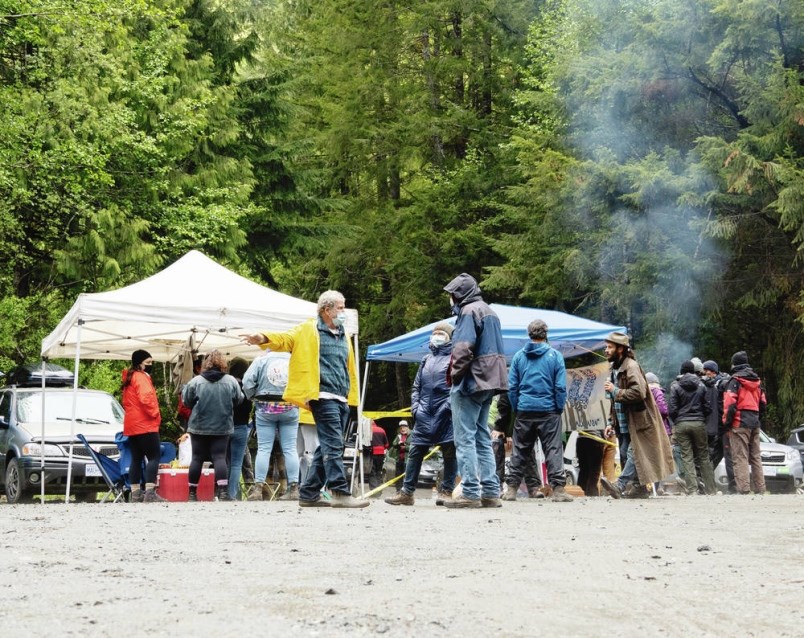Forestry companies on the coast are dependent on old-growth logging for at least the next decade because second-growth trees aren’t yet big enough to be harvested, says the co-author of an old-growth strategic review.
Registered professional forester Garry Merkel said forest companies told him and co-author Al Gorley while working on the review that they all have long-term plans to phase out dependency on old-growth in roughly 10 to 20 years.
Until then, they’re dependent on old-growth forestry for survival, he said.
Torrance Coste, national campaign director for the Wilderness Committee, said second-growth trees have not grown enough to be harvested because companies have logged too much too quickly, and he rejects the notion that there’s nothing that can be done to eliminate the logging industry’s dependency on old-growth trees.
“We’re not quite ready to make the shift? Let’s make ourselves ready,” he said. “We can intervene in economic and … policy measures. We can’t intervene in terms of what ecosystems need.”
While the old-growth strategic review released last year calls for a logging deferral in old forests where ecosystems are at very high risk of irreversible biodiversity loss, instead of an outright ban, Coste said assessments of how much old growth is needed to preserve biological integrity will likely show that everything standing will need to be protected at least for 600 or 700 years.
Old-growth trees make up about a quarter of all harvesting in the province and are used to make products that are generally valued for their esthetic, said Susan Yurkovich, president and CEO of the B.C. Council of Forest Industries.
“It’s stuff that you see, not generally stuff that’s structural,” she said. “So the shakes and shingles on your house. You could have a cedar roof, you walk in and you see a beautiful kind of wood-panelled wall.”
Old-growth is also used to make decks, siding, carved art pieces and piano sound boards, she said.
Harvesting old-growth trees supports 38,000 jobs in the province and provides $3.5 billion to B.C.’s gross domestic product, Yurkovich said, and there are products that would not be made from second-growth.
Activists determined to stop logging in what they say is the last unprotected, intact old-growth valley on southern Vancouver Island have set up blockades on logging roads near Port Renfrew and Lake Cowichan to prevent industry from accessing the area, but they say they do not oppose harvesting second-growth trees.
Many have blamed the conflict playing out in the woods on Premier John Horgan’s NDP government, saying it has failed to act quickly on recommendations in the strategic review.
Merkel said while the government’s work has taken longer than expected, he can understand the slower pace given its “daunting” task.
“This is going to the core of who we are as British Columbians. We built British Columbia on the backs of the timber industry. And we will always have a forest processing sector. But we’re working toward completely restructuring that sector. So, it’s going to be a big change, and big changes of this magnitude take time,” said Merkel, a registered professional forester since the 1980s who has largely focused on public policy in recent years.
While Merkel doesn’t think B.C. will shift to a complete moratorium on old-growth logging, he and Gorley recommend in their review a shift from managing forestry for timber supply to making ecosystem health a priority. “We can all agree on that. It’s just the transition of how do you get from here to there that is the difficult part.”
Merkel said the conversation around forestry practices is often oversimplified and framed as either complete protection or logging. “We’re not talking about how to manage properly. We’re talking about yes or no. And the conversation gets boiled down to that and really dumbing down, frankly.”
RCMP officers, tasked with clearing the way for logging by a court injunction, had arrested 194 people as of Tuesday, at least nine of whom had been arrested more than once.
Officers cleared some areas, but a steady stream of activists — some of whom chain themselves to gates and vehicles, or cement their arms into the ground — is repopulating blockades.
The province has agreed to a request by the Pacheedaht, Ditidaht and Huu-ay-aht First Nations to defer logging in about 2,000 hectares of old-growth forest for two years, but activists say the deferral falls short and they will continue efforts to protect old-growth in the area.



